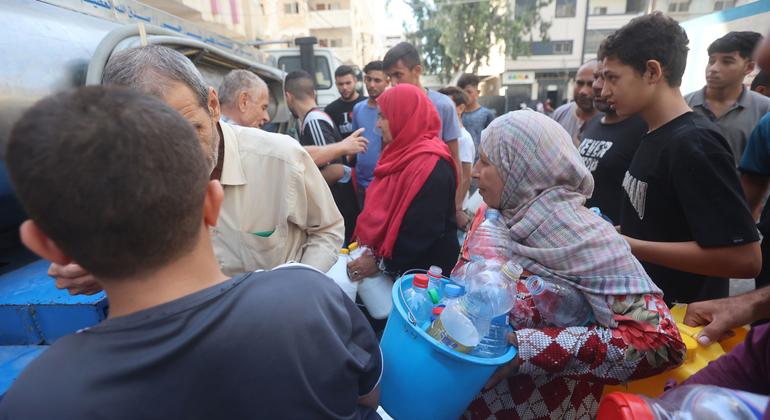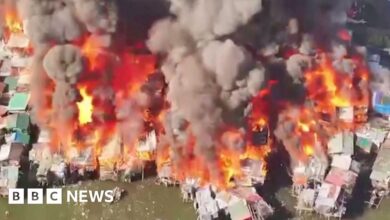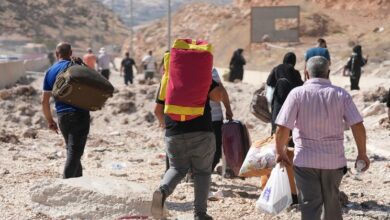Gaza: Latest evacuation order leaves civilians dangerously close to frontline

More than 10 months after the war in Gaza, sparked by Hamas-led terrorist attacks in Israel that left some 1,250 people dead and more than 250 taken hostage, Almost all of Gaza’s population has been displaced at least once. – and often multiple times – by repeated evacuation orders and heavy Israeli shelling.

Kamal Al-Sultan, a displaced child from Beit Lahia in northern Gaza, has been forced to move seven times during the 10-month war.
“Nowhere in the Gaza Strip is safe…It feels like everyone is waiting for death,” speak Louise Wateridge, spokeswoman for the UN agency for Palestinian refugees, in an online message on X.
“Areas that used to be humanitarian (areas) are now on the front lines,” she said. United Nations Newswhile noting that Gazans “are now never more than a few blocks from the front line.”
Kamal Al-Sultan, a displaced child from Beit Lahia in northern Gaza, speak United Nations News in Gaza that he has been displaced seven times since the war beganmost recently from Deir Al-Balah Boys’ Preparatory School, where the boy sought shelter and safety.
“We moved from Beit Lahia to Deir Al-Balah, and now they are asking us to leave,” he said. United Nations News. “We don’t know where to go.”
‘It’s like your soul leaves your body’
According to the United Nations agency for Palestine refugees, UNRWAThese new evacuation orders now cover about 84 percent of the Gaza Strip. Meanwhile, many Gazans are once again being forced to move.
“This relocation from Deir Al-Balah is our fourteenth”, said Yahya Halas, a displaced person from the Shujaiya neighborhood in eastern Gaza City. “We have been evacuated from Shujaiya to al-Zahraa city to Rafah to Khan Younis twice and to Deir Al-Balah three times. How long will this last?”
Moving, he said, was “more than just packing a bag.”
“Displacement is like the soul leaving the body,” said Halas. “We have children and women. We have furniture and food. Where will we go when all the displaced people go west? If you go west of Deir Al-Balah, you cannot walk because there are so many people there.”
Critical axis cut
In its latest update on the emergency, the United Nations Office for the Coordination of Humanitarian Affairs, OCHAstressed that “relentless” hostilities and ongoing evacuation orders in Gaza have continued to limit relief operations “which are already hampered by access restrictions, fuel shortages and other challenges.”
OCHA reported that several sections of Salah ad Din – a key route for humanitarian operations from south to north – were blocked by an evacuation order issued by Israeli authorities on Saturday in Deir Al-Balah.
“This makes it nearly impossible for aid workers to move along this vital route,” the report noted. The Israel Defense Forces issued a new order affecting downtown neighborhoods on Wednesday morning.
OCHA added that the Gaza coastal route was “no longer a viable alternative”, explaining that beaches along the route were “filled with temporary shelters” for Palestinians forced to flee their homes.
“As a result, Convoy movement along the coastal route is extremely slow, and vital supplies and services – such as trucking water – are not reaching those who need it at nearly the scale they should,” The United Nations aid office warns.
Tanks in Khan Younis
In Khan Younis, where Israeli tanks have returned, UNRWA expressed growing concern that vital facilities in areas of the southern city scheduled to be evacuated could soon be damaged or destroyed.
Among them are the newly restored water pumping station serving some 100,000 people, the UNRWA Japan Medical Center, which reopened last month and is expected to play a key role in the upcoming polio vaccination campaign, and the Khan Younis Training Center, a large facility now used as a warehouse to store humanitarian supplies.
“Without that warehouse, we wouldn’t be able to bring in relief supplies and put them anywhere,” Ms Wateridge explained. “There’s no warehouse anymore.”
“You have water, you have medicines and vaccines and you have distribution systems; if any of these facilities are damaged and destroyed, it would be catastrophic,” she said. United Nations News.




